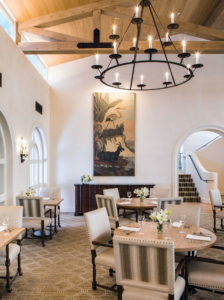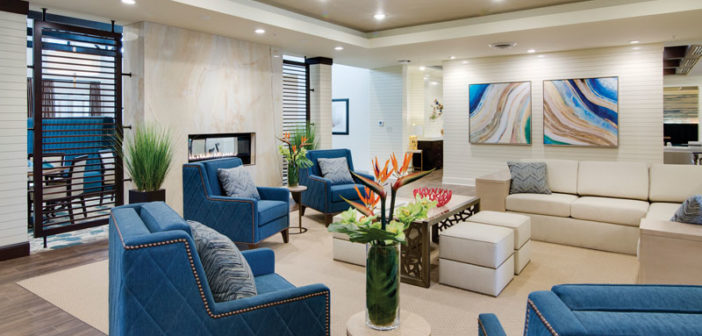NATIONAL REPORT—For many, senior-living environments evoke images of uninspired, institutional aesthetics more reminiscent of a hospital or doctor’s waiting room than a place for people to live out their golden years. But that’s not the case anymore. Taking inspiration from the hospitality industry—and the authentic, experiential vibe modern hotels are known for—senior-living communities are being upended.
“Senior-living communities have really come a long way; there’s still a lot of stereotypes about them—that they’re traditional, they’re staid, it’s all about basket weaving, bingo and cards. And that it’s, as my mother used to say, God’s waiting room,” said Dean Maddalena, founder and president of StudioSIX5 and Shift Studio Design.
But that couldn’t be further from the truth today. While the original senior-living communities were located in the suburbs and put security at a premium—it was the number-one reason why someone would move in—seniors today want to immerse themselves in the community.
Jennifer Chesek, VP, hospitality and senior living, Beyer-Brown & Associates LP, said, “The modern-day environment is definitely more about experiences and staying current. Everything from the addition of spas and restaurant dining concepts to incorporating the latest in technology has made these environments current. The focus has certainly shifted from the idea of a ‘care facility’ to developing ‘a sophisticated and active lifestyle’ for seniors.”
“When we design now, we’re not just designing for the seniors living there, we’re really designing for all generations, whether it’s families, the caregivers, the administration,” Maddalena said.
Lisa Cini, owner of Mosaic Design Studio, agreed. “Senior-living environments are a mash up of your country club and favorite hotel with a personal nurse (on an as-needed basis),” she said. “Our latest projects are so attractive that my kids want to live there (ages 21 and 24). In the past, they were disconnected from the community at large, with one large dining room that you ate three meals a day in, a bingo room and a sidewalk that constituted your outdoor space. Now, we have multiple, themed restaurants with farm to table and private label wines, fire pits, pools, fitness and spa facilities, incredible outdoor spaces, pubs, coffee shops, art rooms, libraries, conference spaces to hold your board meeting, demonstration cooking spaces and various other spaces. These are now spaces where you can live and grow and connect versus ones where you go to comfortably die.”
Joel Villalon, principal, BraytonHughes Design Studios, added, “The biggest changes we’re seeing have to do with the type of environments—the aesthetic and the different type of communal experiences that people have within each one. There’s a big focus on health—not necessarily physical health, but mental health, and what makes people happy, and what kinds of opportunities as designers we can bring to the table to create these moments where community is experienced… There’s a lot of places to help people reinvigorate their mind and keep them active.”
What’s driving these changes? There’s a new generation of seniors in the world.

Casa Dorinda in Montecito, CA, is one of BraytonHughes Design Studios’ recent senior-living projects
“You have the generation that the original retirement communities were planned around, then the silent generation that came in who wanted more options, but now you’re really looking at baby boomers,” Maddalena said. “They’re not necessarily moving into the communities, but they’re assisting their parents. When we’re designing the community, we’re not just designing for the 84-year-old mother moving in, we’re also designing for the late-50s daughter who is assisting her parent. They want something more than what was historically there.”
Villalon agreed. “Baby boomers are starting to retire and their level of expectation in terms of what they feel a space they may want to spend the next 20 or 30 years is different,” he said. “Developers and owners are addressing that.”
“Boomers don’t want to be disconnected—they are demanding technology that keeps them connected. And nature is greatly important—being able to engage outside with safety,” Cini said. “And then there’s freedom: The silent generation was all about safety and duty, boomers are about freedom and connection. The environment has to support this.”
So what are they looking for, exactly?
“Seniors are looking for a high level of comfort and inviting spaces to socialize not only with each other, but to host their families when they visit,” Chesek said. “You now see inviting spaces like spas, libraries and even bars being incorporated into the design.”
Cini listed the biggest desires for seniors: “Bring nature in though large windows and seamlessly merge beautiful outdoor and indoor spaces; full WiFi everywhere (so much so that you can live stream Monday night football); smart closets that hold two to three times the amount of clothes than a traditional rod and shelf; smart lighting and sensors that help us to wake up, sleep better and feel safe; great acoustics so that hearing is not an issue and we can engage; the environments need to be modeled after top restaurants so that you can have multiple experiences and menus depending on what you feel like at that moment; and fitness spas with equipment that has specifically been designed for an aging body with low impact but high results.”
If biophilic design, great WiFi, great acoustics, fantastic F&B and a focus on health and wellness sound like hotels to you—you’re not wrong. When asked whether senior-living environments were being influenced by hotels, Maddalena responded, “Without a doubt.”
He continued, “Ever since I’ve been doing this, I really look at the hospitality industry for ideas and influences on how it can apply to senior-living environments. People don’t really think about it, but all the research and planning hospitality is doing on the millennial side with the socialization aspect, that’s what seniors want also.”
“Let’s remember that seniors today have spent the last 20 or so years traveling and experiencing the more residential upgraded feel of hotels and the amenities they offer,” Chesek said. “Naturally, this has influenced their expectations when looking at senior-living communities. Technology you see in hotel design is also being brought into senior living. Lighting is a common area you see this, but also the use of keycards and keyless entry are technologies used that mimic hospitality.”
While Cini agreed hospitality has been a major influence, she also cautioned, “But people also don’t want to live in a hotel. The design team has to balance the hospitality look and feel with what I call soul space—space that relaxes your entire body and feels good to your soul. A hotel might be strikingly beautiful but, typically, you don’t feel comfortable.”
While senior-living environments are being influenced by hotels, hospitality could also learn a bit from senior living.
“As boomers age, hospitality needs to address design elements that help support aging eyes, hips, knees and hearing,” Cini said. “I travel a ton and have trouble sometimes with the lighting and noise levels in restaurants (and I am only 50). Sensor lighting and universal design elements and safety features in bathrooms are not just for those with disabilities anymore.”
Villalon noted some of the design elements being added into senior-living environments that could be useful for hotels looking to target that demographic—specifically, what to do about furniture. In senior-living environments, he said, “all chairs have to have arms. The fabric on the seat has to be such so they don’t slide off. The incline should be such they won’t have trouble getting in or out. We sometimes will design cubbies that hold cushions so if people are shorter or taller and, if you have the same dining chair throughout the space, you’re able to elevate someone by putting the cushion down.
“The other thing we look at is dining chairs that might have two wheels on the front and stationary in the back, and the weight is such that a person can reasonably move them easily back and forth, so they can get in and out,” he added.
The most important consideration in designing a space for seniors, he said, is to “think about what you would want in your home and how you would like to live, and try to take those things into consideration.” HB


